Entrepreneurship and Small Business Management: Venture Types, Impact
VerifiedAdded on 2024/05/20
|22
|5396
|438
Report
AI Summary
This report explores various aspects of entrepreneurship and small business management, beginning with an examination of different entrepreneurial venture types, including small, micro, and medium-sized organizations, and highlighting their similarities and differences. It assesses the economic impact of small businesses, using data and statistics to illustrate their role in employment and economic growth, particularly within the social economy. The report also delves into the entrepreneurial mindset, identifying key traits and skills that differentiate successful entrepreneurs from other business managers, and explores how personal background and experience can either foster or hinder entrepreneurial endeavors. The analysis draws upon relevant examples and research to provide a comprehensive understanding of the factors influencing entrepreneurship and small business success. Desklib offers a wealth of similar resources and solved assignments to support students in their studies.

ENTREPRENEURSHIP AND SMALL BUSINESS MANAGEMENT
1
1
Paraphrase This Document
Need a fresh take? Get an instant paraphrase of this document with our AI Paraphraser
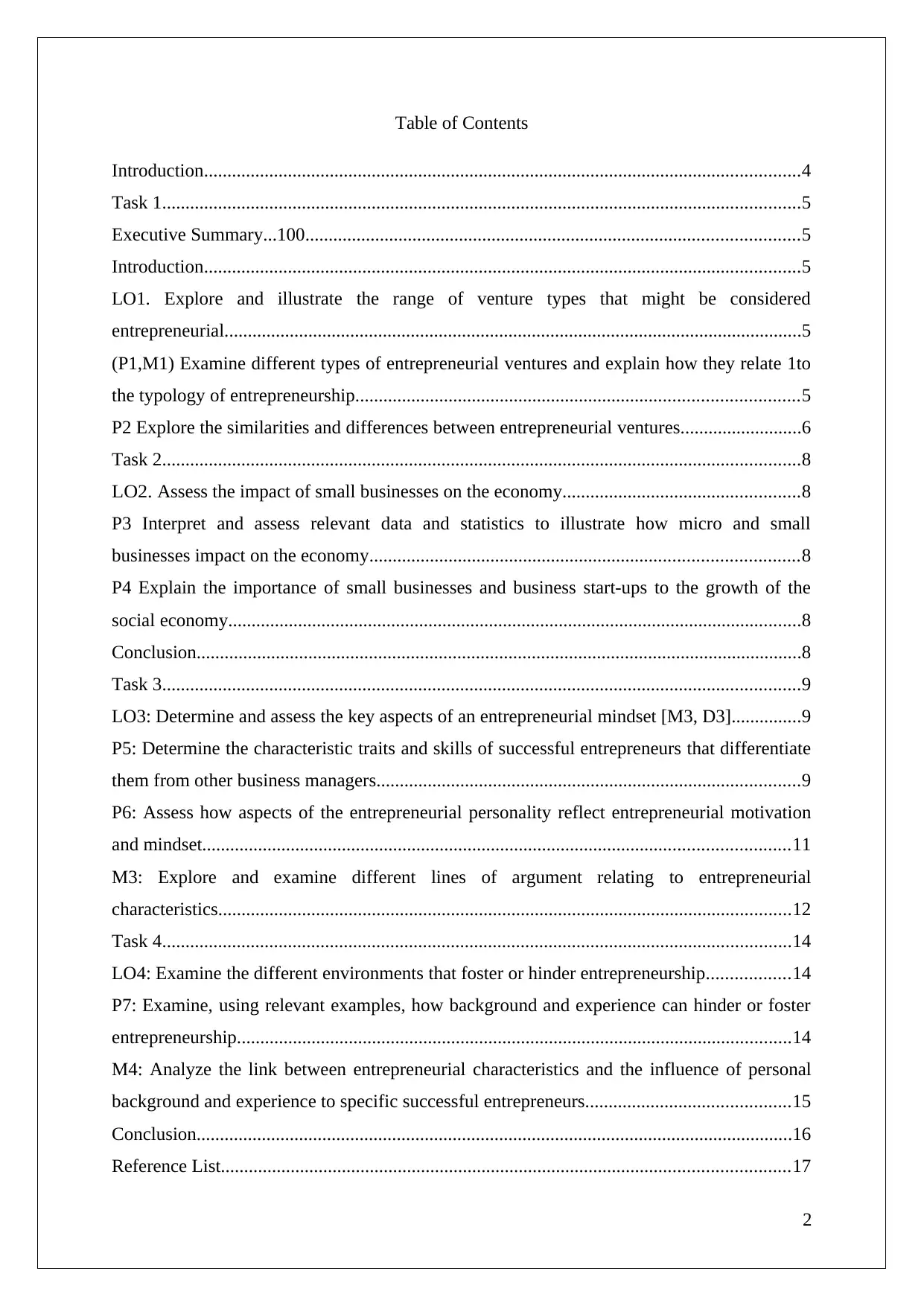
Table of Contents
Introduction................................................................................................................................4
Task 1.........................................................................................................................................5
Executive Summary...100..........................................................................................................5
Introduction................................................................................................................................5
LO1. Explore and illustrate the range of venture types that might be considered
entrepreneurial............................................................................................................................5
(P1,M1) Examine different types of entrepreneurial ventures and explain how they relate 1to
the typology of entrepreneurship...............................................................................................5
P2 Explore the similarities and differences between entrepreneurial ventures..........................6
Task 2.........................................................................................................................................8
LO2. Assess the impact of small businesses on the economy...................................................8
P3 Interpret and assess relevant data and statistics to illustrate how micro and small
businesses impact on the economy............................................................................................8
P4 Explain the importance of small businesses and business start-ups to the growth of the
social economy...........................................................................................................................8
Conclusion..................................................................................................................................8
Task 3.........................................................................................................................................9
LO3: Determine and assess the key aspects of an entrepreneurial mindset [M3, D3]...............9
P5: Determine the characteristic traits and skills of successful entrepreneurs that differentiate
them from other business managers...........................................................................................9
P6: Assess how aspects of the entrepreneurial personality reflect entrepreneurial motivation
and mindset..............................................................................................................................11
M3: Explore and examine different lines of argument relating to entrepreneurial
characteristics...........................................................................................................................12
Task 4.......................................................................................................................................14
LO4: Examine the different environments that foster or hinder entrepreneurship..................14
P7: Examine, using relevant examples, how background and experience can hinder or foster
entrepreneurship.......................................................................................................................14
M4: Analyze the link between entrepreneurial characteristics and the influence of personal
background and experience to specific successful entrepreneurs............................................15
Conclusion................................................................................................................................16
Reference List..........................................................................................................................17
2
Introduction................................................................................................................................4
Task 1.........................................................................................................................................5
Executive Summary...100..........................................................................................................5
Introduction................................................................................................................................5
LO1. Explore and illustrate the range of venture types that might be considered
entrepreneurial............................................................................................................................5
(P1,M1) Examine different types of entrepreneurial ventures and explain how they relate 1to
the typology of entrepreneurship...............................................................................................5
P2 Explore the similarities and differences between entrepreneurial ventures..........................6
Task 2.........................................................................................................................................8
LO2. Assess the impact of small businesses on the economy...................................................8
P3 Interpret and assess relevant data and statistics to illustrate how micro and small
businesses impact on the economy............................................................................................8
P4 Explain the importance of small businesses and business start-ups to the growth of the
social economy...........................................................................................................................8
Conclusion..................................................................................................................................8
Task 3.........................................................................................................................................9
LO3: Determine and assess the key aspects of an entrepreneurial mindset [M3, D3]...............9
P5: Determine the characteristic traits and skills of successful entrepreneurs that differentiate
them from other business managers...........................................................................................9
P6: Assess how aspects of the entrepreneurial personality reflect entrepreneurial motivation
and mindset..............................................................................................................................11
M3: Explore and examine different lines of argument relating to entrepreneurial
characteristics...........................................................................................................................12
Task 4.......................................................................................................................................14
LO4: Examine the different environments that foster or hinder entrepreneurship..................14
P7: Examine, using relevant examples, how background and experience can hinder or foster
entrepreneurship.......................................................................................................................14
M4: Analyze the link between entrepreneurial characteristics and the influence of personal
background and experience to specific successful entrepreneurs............................................15
Conclusion................................................................................................................................16
Reference List..........................................................................................................................17
2
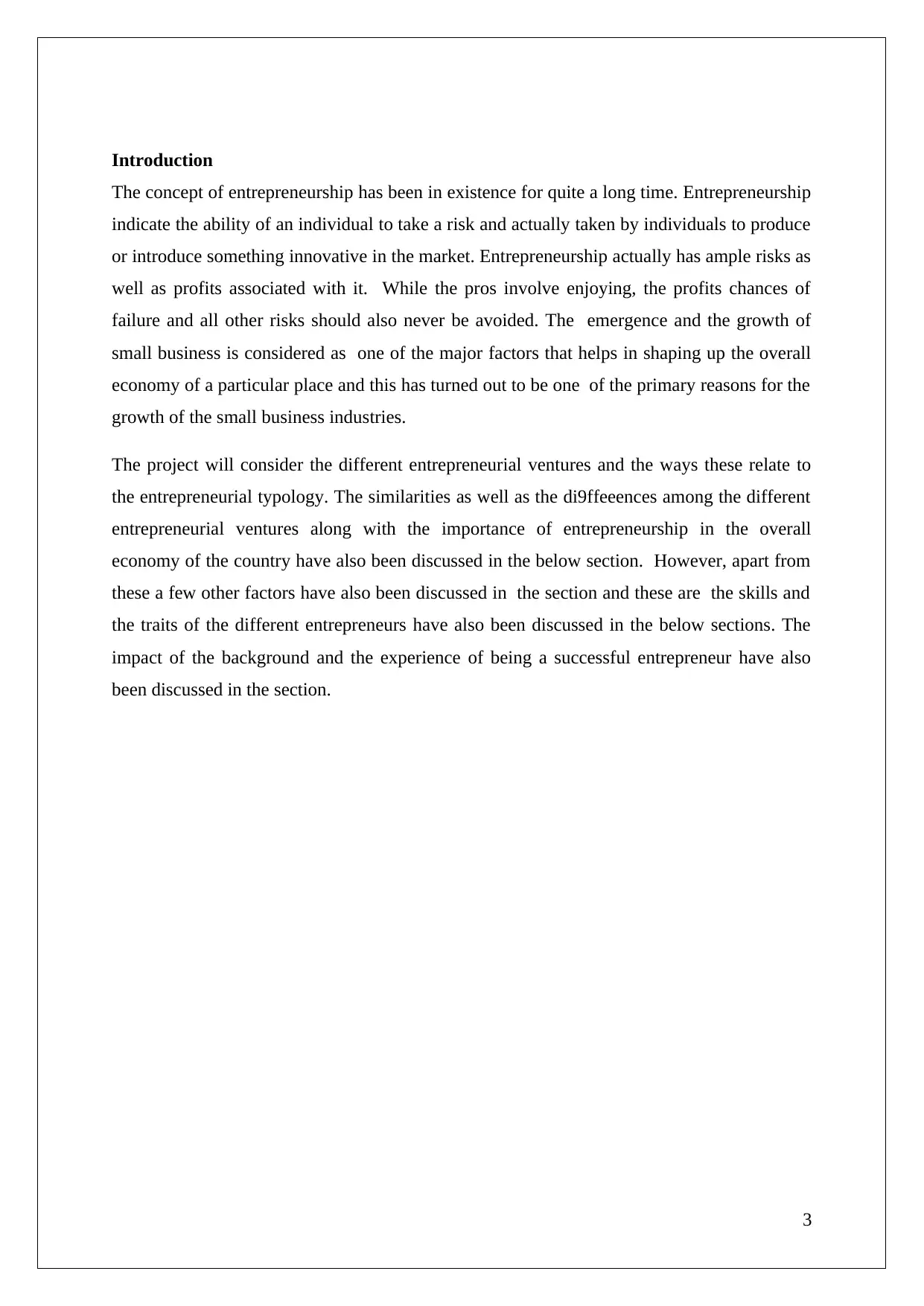
Introduction
The concept of entrepreneurship has been in existence for quite a long time. Entrepreneurship
indicate the ability of an individual to take a risk and actually taken by individuals to produce
or introduce something innovative in the market. Entrepreneurship actually has ample risks as
well as profits associated with it. While the pros involve enjoying, the profits chances of
failure and all other risks should also never be avoided. The emergence and the growth of
small business is considered as one of the major factors that helps in shaping up the overall
economy of a particular place and this has turned out to be one of the primary reasons for the
growth of the small business industries.
The project will consider the different entrepreneurial ventures and the ways these relate to
the entrepreneurial typology. The similarities as well as the di9ffeeences among the different
entrepreneurial ventures along with the importance of entrepreneurship in the overall
economy of the country have also been discussed in the below section. However, apart from
these a few other factors have also been discussed in the section and these are the skills and
the traits of the different entrepreneurs have also been discussed in the below sections. The
impact of the background and the experience of being a successful entrepreneur have also
been discussed in the section.
3
The concept of entrepreneurship has been in existence for quite a long time. Entrepreneurship
indicate the ability of an individual to take a risk and actually taken by individuals to produce
or introduce something innovative in the market. Entrepreneurship actually has ample risks as
well as profits associated with it. While the pros involve enjoying, the profits chances of
failure and all other risks should also never be avoided. The emergence and the growth of
small business is considered as one of the major factors that helps in shaping up the overall
economy of a particular place and this has turned out to be one of the primary reasons for the
growth of the small business industries.
The project will consider the different entrepreneurial ventures and the ways these relate to
the entrepreneurial typology. The similarities as well as the di9ffeeences among the different
entrepreneurial ventures along with the importance of entrepreneurship in the overall
economy of the country have also been discussed in the below section. However, apart from
these a few other factors have also been discussed in the section and these are the skills and
the traits of the different entrepreneurs have also been discussed in the below sections. The
impact of the background and the experience of being a successful entrepreneur have also
been discussed in the section.
3
⊘ This is a preview!⊘
Do you want full access?
Subscribe today to unlock all pages.

Trusted by 1+ million students worldwide
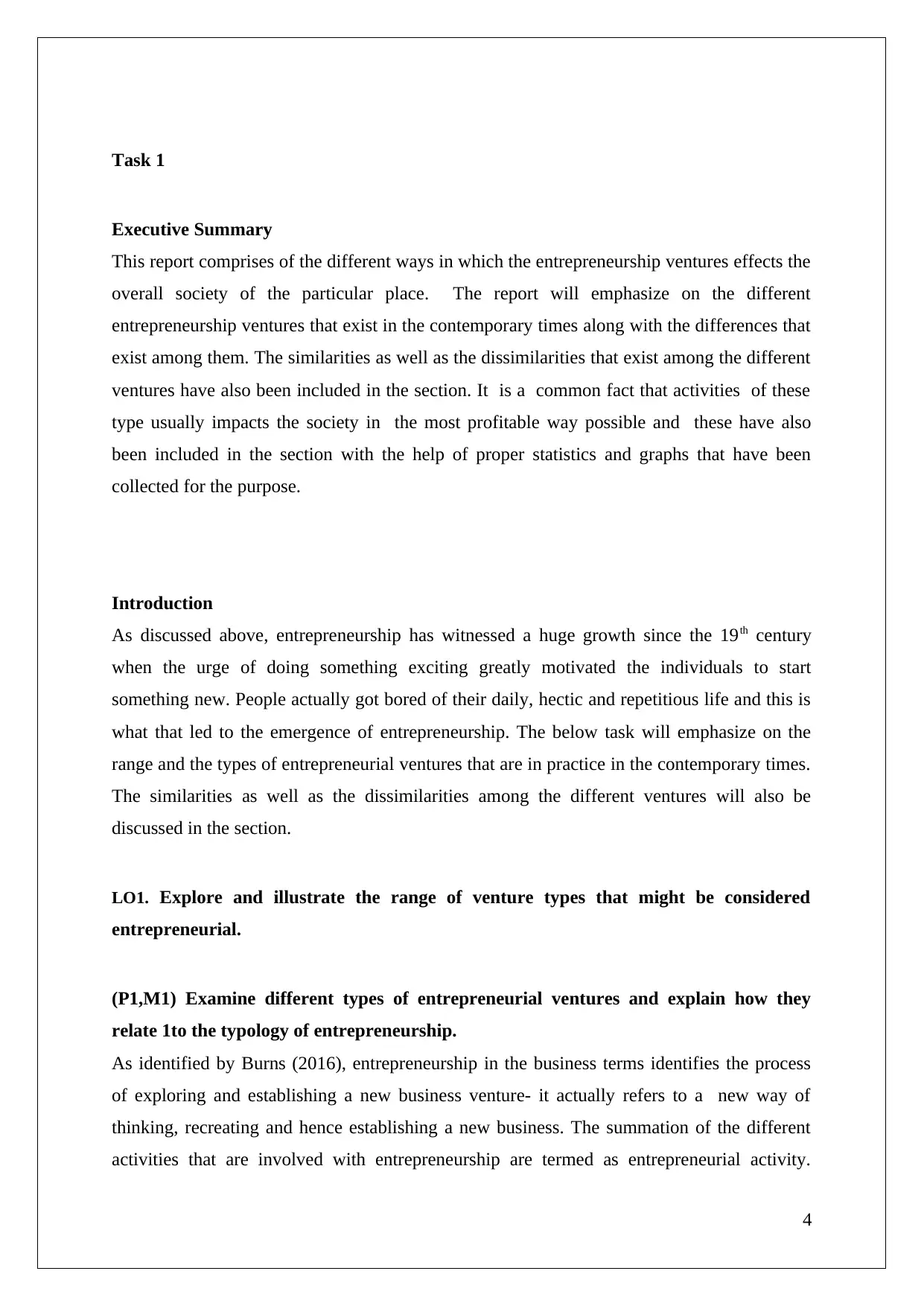
Task 1
Executive Summary
This report comprises of the different ways in which the entrepreneurship ventures effects the
overall society of the particular place. The report will emphasize on the different
entrepreneurship ventures that exist in the contemporary times along with the differences that
exist among them. The similarities as well as the dissimilarities that exist among the different
ventures have also been included in the section. It is a common fact that activities of these
type usually impacts the society in the most profitable way possible and these have also
been included in the section with the help of proper statistics and graphs that have been
collected for the purpose.
Introduction
As discussed above, entrepreneurship has witnessed a huge growth since the 19th century
when the urge of doing something exciting greatly motivated the individuals to start
something new. People actually got bored of their daily, hectic and repetitious life and this is
what that led to the emergence of entrepreneurship. The below task will emphasize on the
range and the types of entrepreneurial ventures that are in practice in the contemporary times.
The similarities as well as the dissimilarities among the different ventures will also be
discussed in the section.
LO1. Explore and illustrate the range of venture types that might be considered
entrepreneurial.
(P1,M1) Examine different types of entrepreneurial ventures and explain how they
relate 1to the typology of entrepreneurship.
As identified by Burns (2016), entrepreneurship in the business terms identifies the process
of exploring and establishing a new business venture- it actually refers to a new way of
thinking, recreating and hence establishing a new business. The summation of the different
activities that are involved with entrepreneurship are termed as entrepreneurial activity.
4
Executive Summary
This report comprises of the different ways in which the entrepreneurship ventures effects the
overall society of the particular place. The report will emphasize on the different
entrepreneurship ventures that exist in the contemporary times along with the differences that
exist among them. The similarities as well as the dissimilarities that exist among the different
ventures have also been included in the section. It is a common fact that activities of these
type usually impacts the society in the most profitable way possible and these have also
been included in the section with the help of proper statistics and graphs that have been
collected for the purpose.
Introduction
As discussed above, entrepreneurship has witnessed a huge growth since the 19th century
when the urge of doing something exciting greatly motivated the individuals to start
something new. People actually got bored of their daily, hectic and repetitious life and this is
what that led to the emergence of entrepreneurship. The below task will emphasize on the
range and the types of entrepreneurial ventures that are in practice in the contemporary times.
The similarities as well as the dissimilarities among the different ventures will also be
discussed in the section.
LO1. Explore and illustrate the range of venture types that might be considered
entrepreneurial.
(P1,M1) Examine different types of entrepreneurial ventures and explain how they
relate 1to the typology of entrepreneurship.
As identified by Burns (2016), entrepreneurship in the business terms identifies the process
of exploring and establishing a new business venture- it actually refers to a new way of
thinking, recreating and hence establishing a new business. The summation of the different
activities that are involved with entrepreneurship are termed as entrepreneurial activity.
4
Paraphrase This Document
Need a fresh take? Get an instant paraphrase of this document with our AI Paraphraser
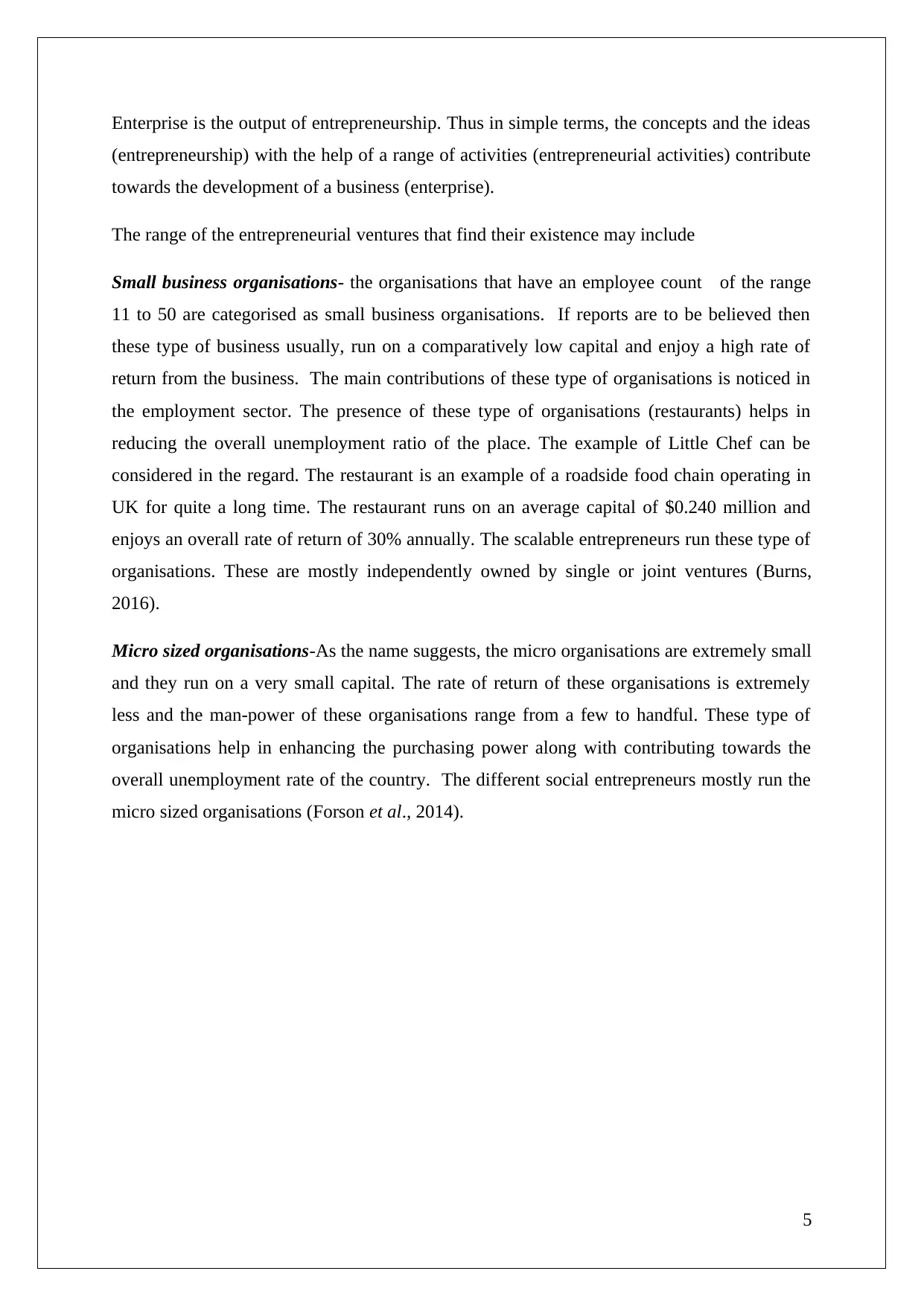
Enterprise is the output of entrepreneurship. Thus in simple terms, the concepts and the ideas
(entrepreneurship) with the help of a range of activities (entrepreneurial activities) contribute
towards the development of a business (enterprise).
The range of the entrepreneurial ventures that find their existence may include
Small business organisations- the organisations that have an employee count of the range
11 to 50 are categorised as small business organisations. If reports are to be believed then
these type of business usually, run on a comparatively low capital and enjoy a high rate of
return from the business. The main contributions of these type of organisations is noticed in
the employment sector. The presence of these type of organisations (restaurants) helps in
reducing the overall unemployment ratio of the place. The example of Little Chef can be
considered in the regard. The restaurant is an example of a roadside food chain operating in
UK for quite a long time. The restaurant runs on an average capital of $0.240 million and
enjoys an overall rate of return of 30% annually. The scalable entrepreneurs run these type of
organisations. These are mostly independently owned by single or joint ventures (Burns,
2016).
Micro sized organisations-As the name suggests, the micro organisations are extremely small
and they run on a very small capital. The rate of return of these organisations is extremely
less and the man-power of these organisations range from a few to handful. These type of
organisations help in enhancing the purchasing power along with contributing towards the
overall unemployment rate of the country. The different social entrepreneurs mostly run the
micro sized organisations (Forson et al., 2014).
5
(entrepreneurship) with the help of a range of activities (entrepreneurial activities) contribute
towards the development of a business (enterprise).
The range of the entrepreneurial ventures that find their existence may include
Small business organisations- the organisations that have an employee count of the range
11 to 50 are categorised as small business organisations. If reports are to be believed then
these type of business usually, run on a comparatively low capital and enjoy a high rate of
return from the business. The main contributions of these type of organisations is noticed in
the employment sector. The presence of these type of organisations (restaurants) helps in
reducing the overall unemployment ratio of the place. The example of Little Chef can be
considered in the regard. The restaurant is an example of a roadside food chain operating in
UK for quite a long time. The restaurant runs on an average capital of $0.240 million and
enjoys an overall rate of return of 30% annually. The scalable entrepreneurs run these type of
organisations. These are mostly independently owned by single or joint ventures (Burns,
2016).
Micro sized organisations-As the name suggests, the micro organisations are extremely small
and they run on a very small capital. The rate of return of these organisations is extremely
less and the man-power of these organisations range from a few to handful. These type of
organisations help in enhancing the purchasing power along with contributing towards the
overall unemployment rate of the country. The different social entrepreneurs mostly run the
micro sized organisations (Forson et al., 2014).
5
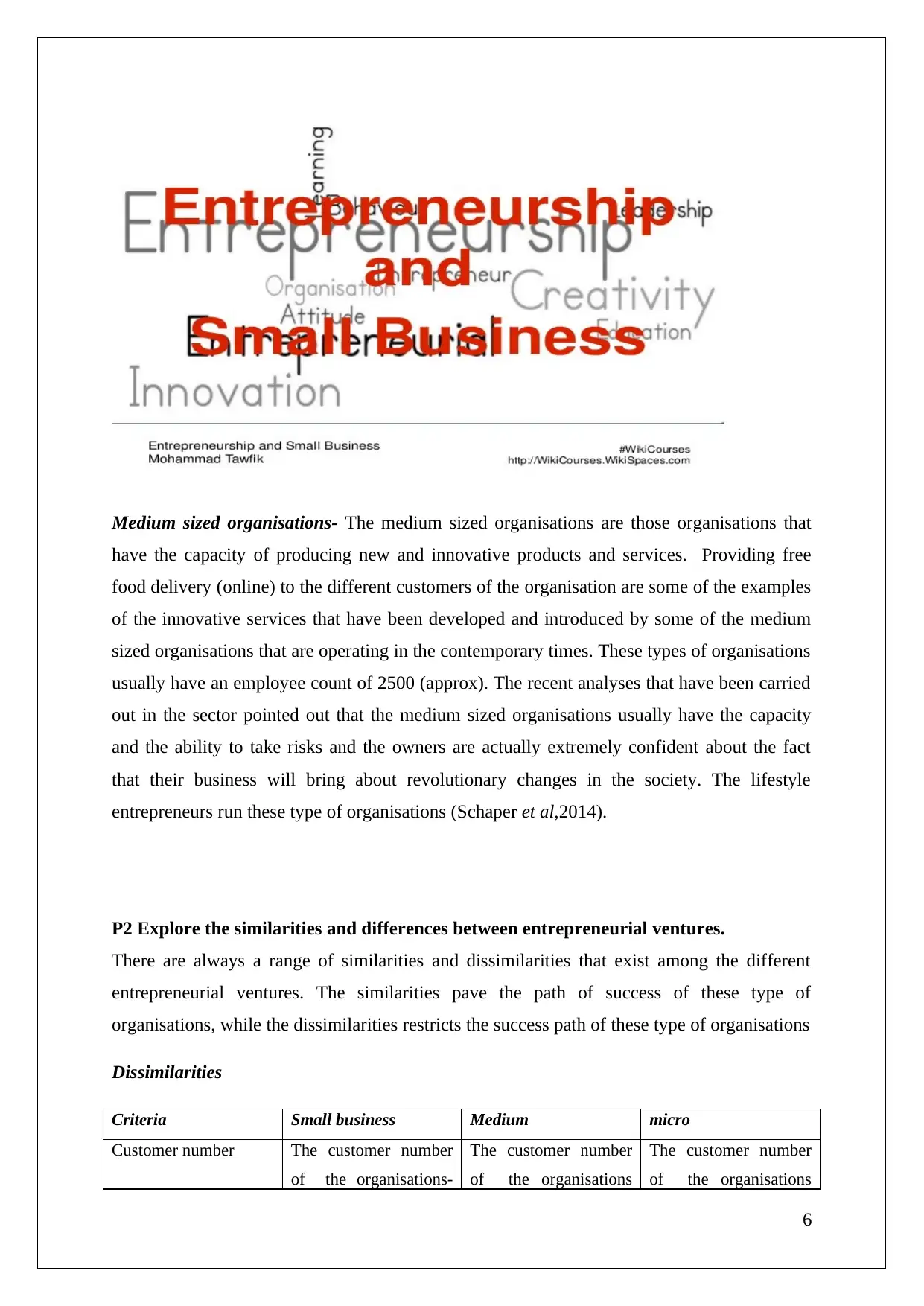
Medium sized organisations- The medium sized organisations are those organisations that
have the capacity of producing new and innovative products and services. Providing free
food delivery (online) to the different customers of the organisation are some of the examples
of the innovative services that have been developed and introduced by some of the medium
sized organisations that are operating in the contemporary times. These types of organisations
usually have an employee count of 2500 (approx). The recent analyses that have been carried
out in the sector pointed out that the medium sized organisations usually have the capacity
and the ability to take risks and the owners are actually extremely confident about the fact
that their business will bring about revolutionary changes in the society. The lifestyle
entrepreneurs run these type of organisations (Schaper et al,2014).
P2 Explore the similarities and differences between entrepreneurial ventures.
There are always a range of similarities and dissimilarities that exist among the different
entrepreneurial ventures. The similarities pave the path of success of these type of
organisations, while the dissimilarities restricts the success path of these type of organisations
Dissimilarities
Criteria Small business Medium micro
Customer number The customer number
of the organisations-
The customer number
of the organisations
The customer number
of the organisations
6
have the capacity of producing new and innovative products and services. Providing free
food delivery (online) to the different customers of the organisation are some of the examples
of the innovative services that have been developed and introduced by some of the medium
sized organisations that are operating in the contemporary times. These types of organisations
usually have an employee count of 2500 (approx). The recent analyses that have been carried
out in the sector pointed out that the medium sized organisations usually have the capacity
and the ability to take risks and the owners are actually extremely confident about the fact
that their business will bring about revolutionary changes in the society. The lifestyle
entrepreneurs run these type of organisations (Schaper et al,2014).
P2 Explore the similarities and differences between entrepreneurial ventures.
There are always a range of similarities and dissimilarities that exist among the different
entrepreneurial ventures. The similarities pave the path of success of these type of
organisations, while the dissimilarities restricts the success path of these type of organisations
Dissimilarities
Criteria Small business Medium micro
Customer number The customer number
of the organisations-
The customer number
of the organisations
The customer number
of the organisations
6
⊘ This is a preview!⊘
Do you want full access?
Subscribe today to unlock all pages.

Trusted by 1+ million students worldwide
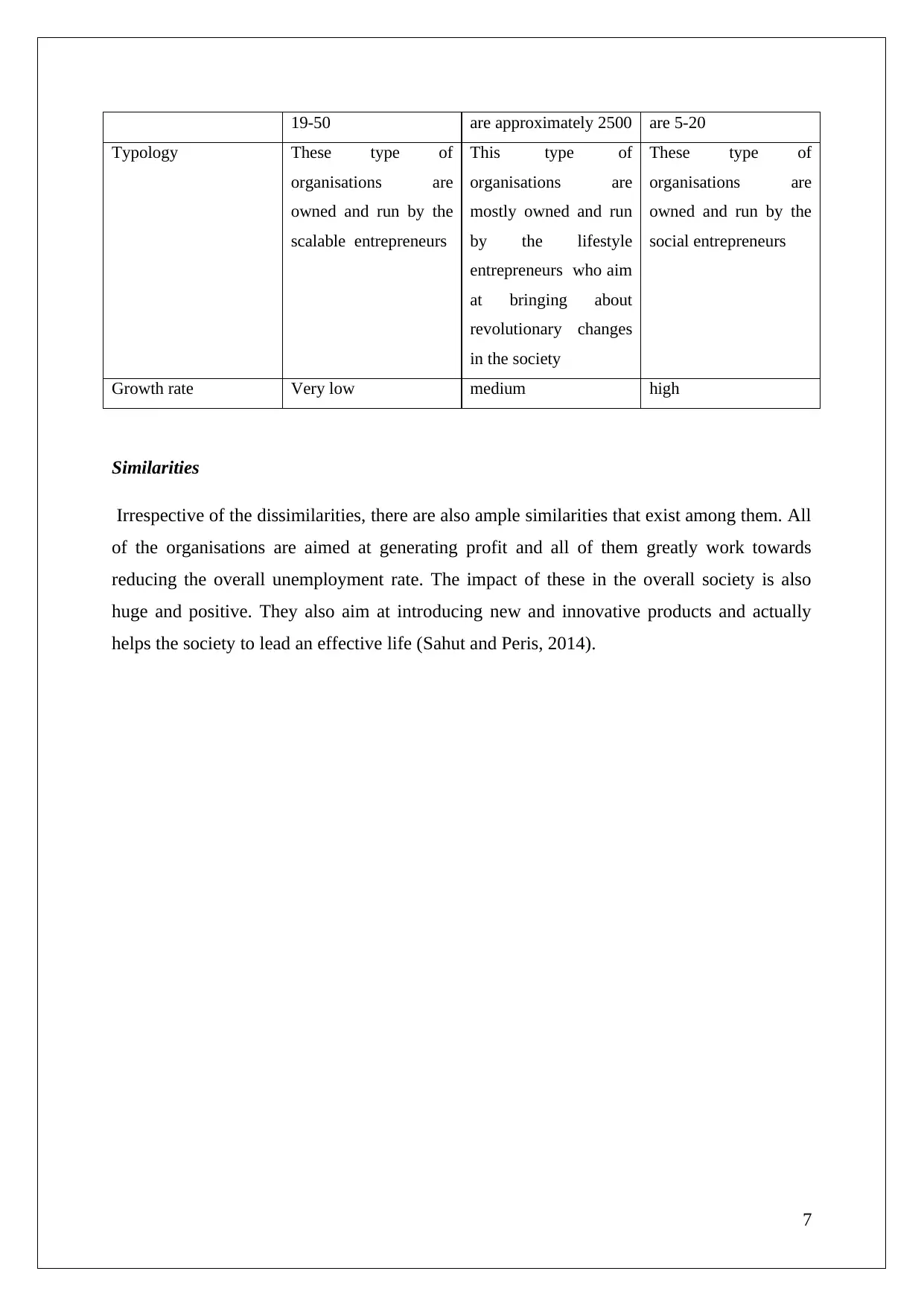
19-50 are approximately 2500 are 5-20
Typology These type of
organisations are
owned and run by the
scalable entrepreneurs
This type of
organisations are
mostly owned and run
by the lifestyle
entrepreneurs who aim
at bringing about
revolutionary changes
in the society
These type of
organisations are
owned and run by the
social entrepreneurs
Growth rate Very low medium high
Similarities
Irrespective of the dissimilarities, there are also ample similarities that exist among them. All
of the organisations are aimed at generating profit and all of them greatly work towards
reducing the overall unemployment rate. The impact of these in the overall society is also
huge and positive. They also aim at introducing new and innovative products and actually
helps the society to lead an effective life (Sahut and Peris, 2014).
7
Typology These type of
organisations are
owned and run by the
scalable entrepreneurs
This type of
organisations are
mostly owned and run
by the lifestyle
entrepreneurs who aim
at bringing about
revolutionary changes
in the society
These type of
organisations are
owned and run by the
social entrepreneurs
Growth rate Very low medium high
Similarities
Irrespective of the dissimilarities, there are also ample similarities that exist among them. All
of the organisations are aimed at generating profit and all of them greatly work towards
reducing the overall unemployment rate. The impact of these in the overall society is also
huge and positive. They also aim at introducing new and innovative products and actually
helps the society to lead an effective life (Sahut and Peris, 2014).
7
Paraphrase This Document
Need a fresh take? Get an instant paraphrase of this document with our AI Paraphraser

Task 2
LO2. Assess the impact of small businesses on the economy.
P3 Interpret and assess relevant data and statistics to illustrate how micro and small
businesses impact on the economy
In every economy, small business plays very important role. It acts as key employer in the
economy. It employs largest segment of the economy. It has been observed in 2000 OECD
policy document of 95% of businesses in each economies consist of small and medium
business while they employ 60 % to 70% of the work force (OECD, 2009).
A 2009 CEPR report by Schmitt and Lane has also referred to the aforementioned OECD
policy document and has given a break down how small businesses spread over different
sectors of economy have been employing available workforces. For example, it has given
share of employment in manufacturing units each of which comprise less than twenty (20)
employees across several countries. The report shows that in the United Kingdom the share
of manufacturing units employing less than twenty (20) employees employs total 18.2 per
cent total employment size in entire manufacturing sector (Schmitt and Lane, 2009).
8
LO2. Assess the impact of small businesses on the economy.
P3 Interpret and assess relevant data and statistics to illustrate how micro and small
businesses impact on the economy
In every economy, small business plays very important role. It acts as key employer in the
economy. It employs largest segment of the economy. It has been observed in 2000 OECD
policy document of 95% of businesses in each economies consist of small and medium
business while they employ 60 % to 70% of the work force (OECD, 2009).
A 2009 CEPR report by Schmitt and Lane has also referred to the aforementioned OECD
policy document and has given a break down how small businesses spread over different
sectors of economy have been employing available workforces. For example, it has given
share of employment in manufacturing units each of which comprise less than twenty (20)
employees across several countries. The report shows that in the United Kingdom the share
of manufacturing units employing less than twenty (20) employees employs total 18.2 per
cent total employment size in entire manufacturing sector (Schmitt and Lane, 2009).
8
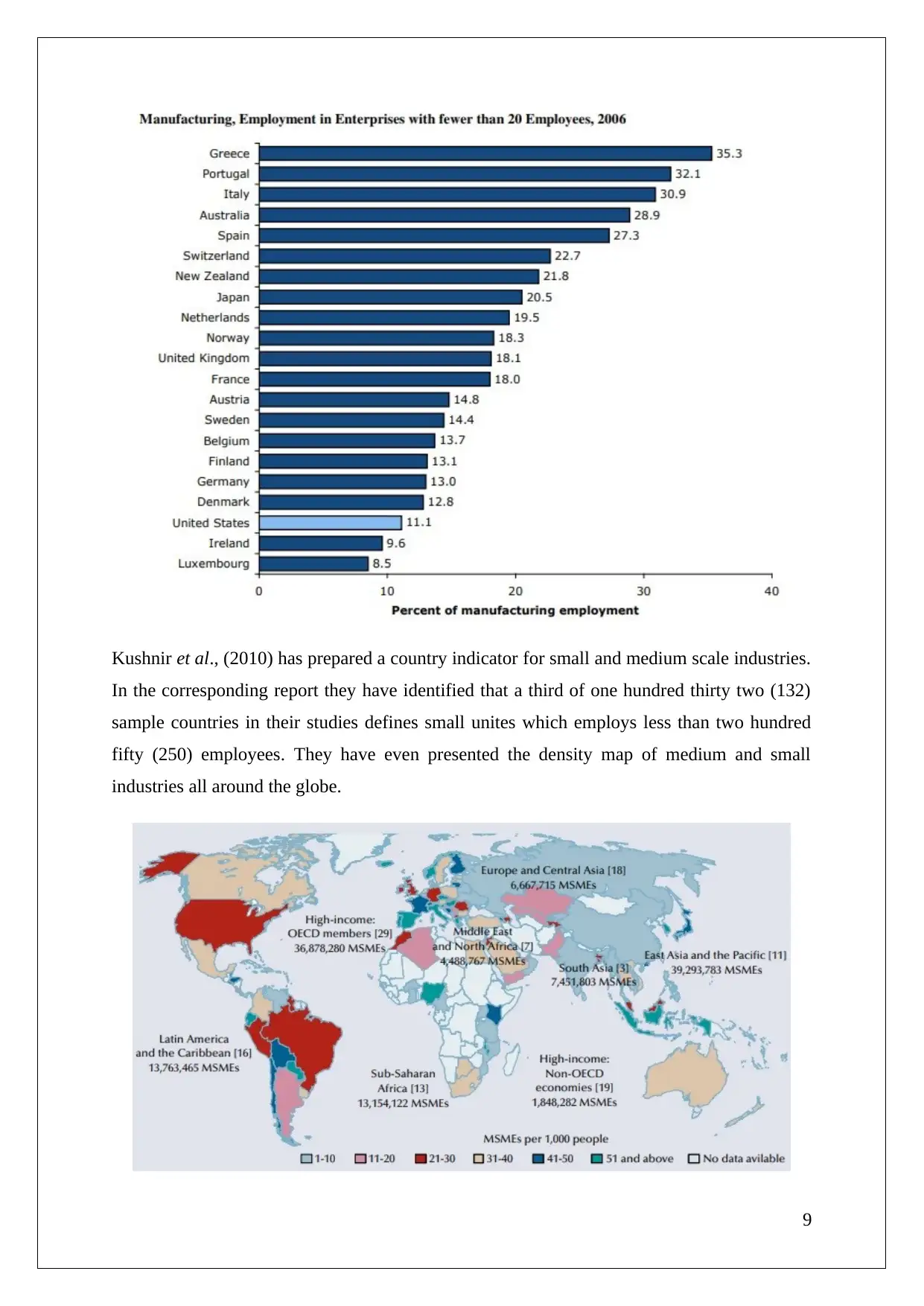
Kushnir et al., (2010) has prepared a country indicator for small and medium scale industries.
In the corresponding report they have identified that a third of one hundred thirty two (132)
sample countries in their studies defines small unites which employs less than two hundred
fifty (250) employees. They have even presented the density map of medium and small
industries all around the globe.
9
In the corresponding report they have identified that a third of one hundred thirty two (132)
sample countries in their studies defines small unites which employs less than two hundred
fifty (250) employees. They have even presented the density map of medium and small
industries all around the globe.
9
⊘ This is a preview!⊘
Do you want full access?
Subscribe today to unlock all pages.

Trusted by 1+ million students worldwide
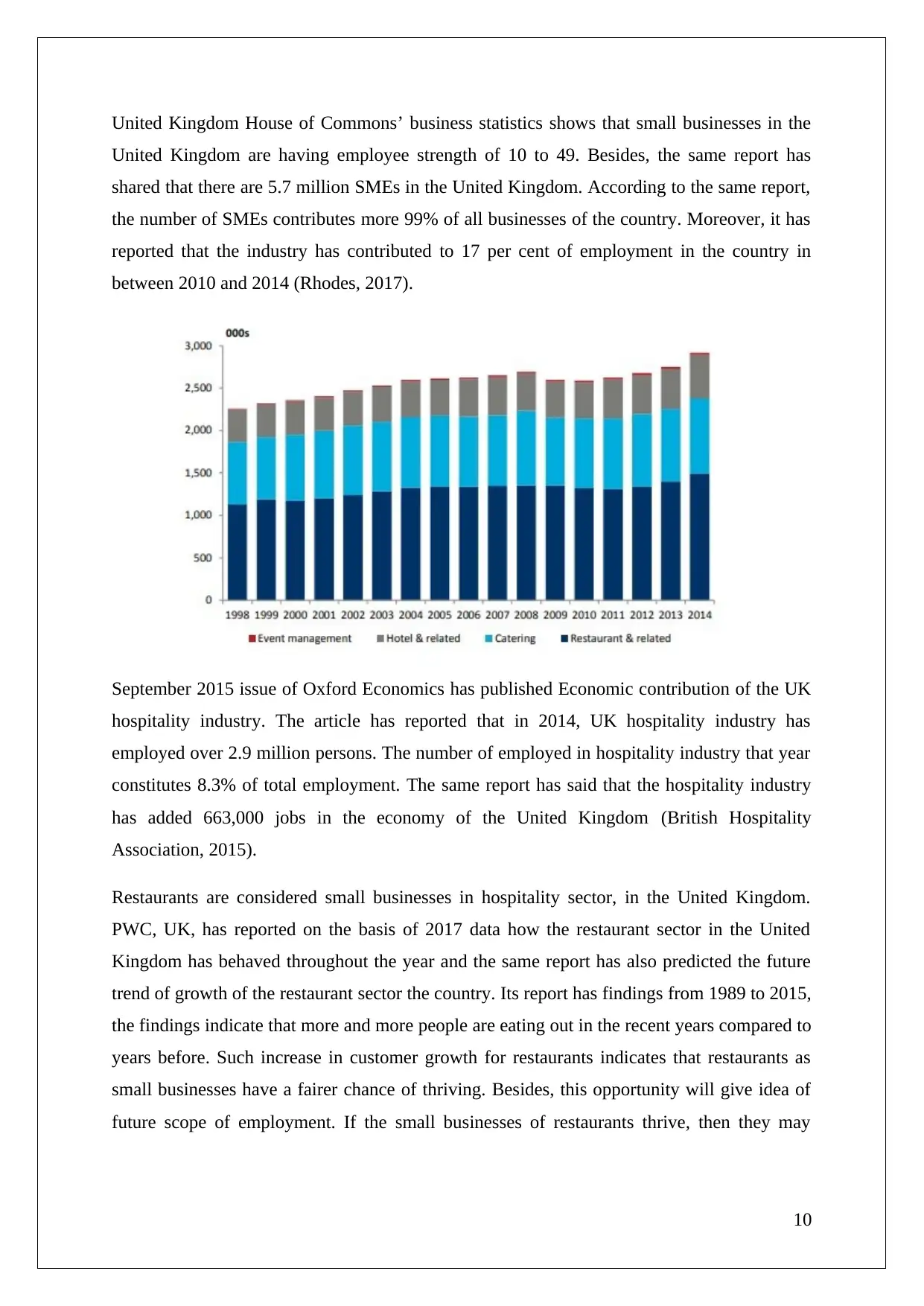
United Kingdom House of Commons’ business statistics shows that small businesses in the
United Kingdom are having employee strength of 10 to 49. Besides, the same report has
shared that there are 5.7 million SMEs in the United Kingdom. According to the same report,
the number of SMEs contributes more 99% of all businesses of the country. Moreover, it has
reported that the industry has contributed to 17 per cent of employment in the country in
between 2010 and 2014 (Rhodes, 2017).
September 2015 issue of Oxford Economics has published Economic contribution of the UK
hospitality industry. The article has reported that in 2014, UK hospitality industry has
employed over 2.9 million persons. The number of employed in hospitality industry that year
constitutes 8.3% of total employment. The same report has said that the hospitality industry
has added 663,000 jobs in the economy of the United Kingdom (British Hospitality
Association, 2015).
Restaurants are considered small businesses in hospitality sector, in the United Kingdom.
PWC, UK, has reported on the basis of 2017 data how the restaurant sector in the United
Kingdom has behaved throughout the year and the same report has also predicted the future
trend of growth of the restaurant sector the country. Its report has findings from 1989 to 2015,
the findings indicate that more and more people are eating out in the recent years compared to
years before. Such increase in customer growth for restaurants indicates that restaurants as
small businesses have a fairer chance of thriving. Besides, this opportunity will give idea of
future scope of employment. If the small businesses of restaurants thrive, then they may
10
United Kingdom are having employee strength of 10 to 49. Besides, the same report has
shared that there are 5.7 million SMEs in the United Kingdom. According to the same report,
the number of SMEs contributes more 99% of all businesses of the country. Moreover, it has
reported that the industry has contributed to 17 per cent of employment in the country in
between 2010 and 2014 (Rhodes, 2017).
September 2015 issue of Oxford Economics has published Economic contribution of the UK
hospitality industry. The article has reported that in 2014, UK hospitality industry has
employed over 2.9 million persons. The number of employed in hospitality industry that year
constitutes 8.3% of total employment. The same report has said that the hospitality industry
has added 663,000 jobs in the economy of the United Kingdom (British Hospitality
Association, 2015).
Restaurants are considered small businesses in hospitality sector, in the United Kingdom.
PWC, UK, has reported on the basis of 2017 data how the restaurant sector in the United
Kingdom has behaved throughout the year and the same report has also predicted the future
trend of growth of the restaurant sector the country. Its report has findings from 1989 to 2015,
the findings indicate that more and more people are eating out in the recent years compared to
years before. Such increase in customer growth for restaurants indicates that restaurants as
small businesses have a fairer chance of thriving. Besides, this opportunity will give idea of
future scope of employment. If the small businesses of restaurants thrive, then they may
10
Paraphrase This Document
Need a fresh take? Get an instant paraphrase of this document with our AI Paraphraser
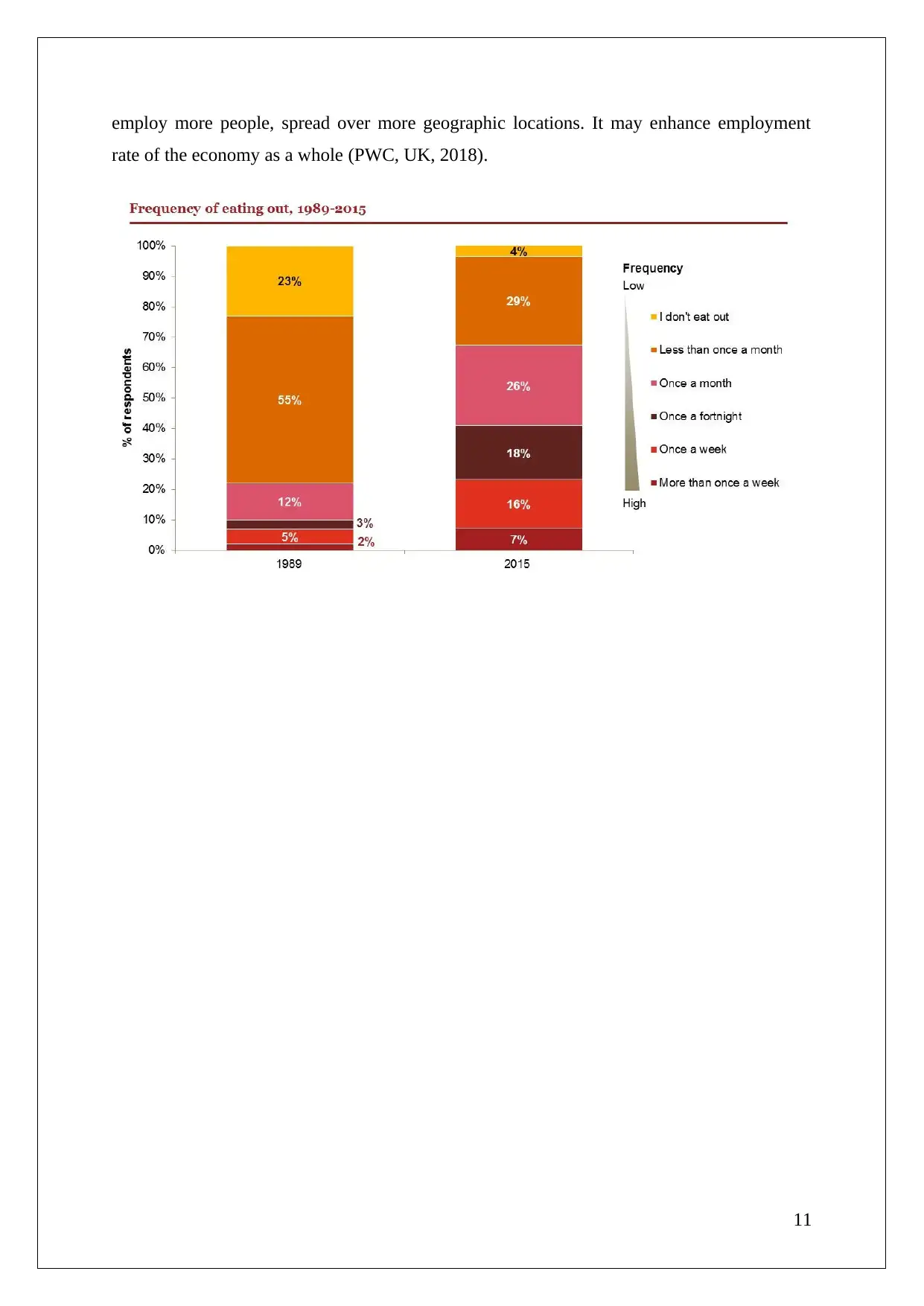
employ more people, spread over more geographic locations. It may enhance employment
rate of the economy as a whole (PWC, UK, 2018).
11
rate of the economy as a whole (PWC, UK, 2018).
11

P4 Explain the importance of small businesses and business start-ups to the growth of
the social economy
As discussed by Storey (2016), social economics identifies the branch of economics that
deals in understanding the relation among the different social behaviours and the constituents
of the society. The impact and the importance of small business in shaping up the overall
economy of the organisation is indeed huge and can be identified in all the levels of the
society- local, international, regional. In the local scenario, the entrepreneurship helps in
enhancing the overall economic conditions of the place. It has been estimated that the
excessive growth of the restaurants as small business firms are some of the vital organisations
that have reduced the unemployment ratio of the particular place. Moreover, since the
restaurants add a whole lot of new and innovative food and dishes to the product line of the
organisation, so the restaurants introduce the localities to a whole lot of new flavours and
dishes. It is an obvious fact that if changes are introduced in the micro level then it will surely
effect the global, national economics of the country and this is exactly how the national and
small business effects the social economy of the place in which it is operating.
Conclusion
The above project has proved to be effective enough in pointing out the similarities as well as
the dissimilarities that exist among the different entrepreneurial ventures. The impact of
entrepreneurship in the overall social economy have also been discussed in the section.
12
the social economy
As discussed by Storey (2016), social economics identifies the branch of economics that
deals in understanding the relation among the different social behaviours and the constituents
of the society. The impact and the importance of small business in shaping up the overall
economy of the organisation is indeed huge and can be identified in all the levels of the
society- local, international, regional. In the local scenario, the entrepreneurship helps in
enhancing the overall economic conditions of the place. It has been estimated that the
excessive growth of the restaurants as small business firms are some of the vital organisations
that have reduced the unemployment ratio of the particular place. Moreover, since the
restaurants add a whole lot of new and innovative food and dishes to the product line of the
organisation, so the restaurants introduce the localities to a whole lot of new flavours and
dishes. It is an obvious fact that if changes are introduced in the micro level then it will surely
effect the global, national economics of the country and this is exactly how the national and
small business effects the social economy of the place in which it is operating.
Conclusion
The above project has proved to be effective enough in pointing out the similarities as well as
the dissimilarities that exist among the different entrepreneurial ventures. The impact of
entrepreneurship in the overall social economy have also been discussed in the section.
12
⊘ This is a preview!⊘
Do you want full access?
Subscribe today to unlock all pages.

Trusted by 1+ million students worldwide
1 out of 22
Related Documents
Your All-in-One AI-Powered Toolkit for Academic Success.
+13062052269
info@desklib.com
Available 24*7 on WhatsApp / Email
![[object Object]](/_next/static/media/star-bottom.7253800d.svg)
Unlock your academic potential
Copyright © 2020–2025 A2Z Services. All Rights Reserved. Developed and managed by ZUCOL.




